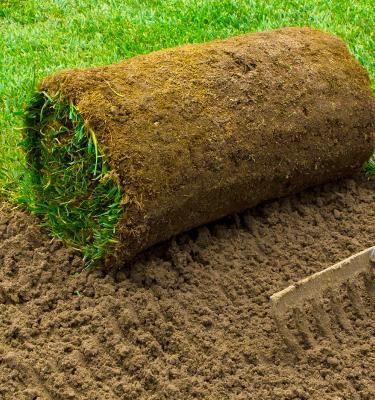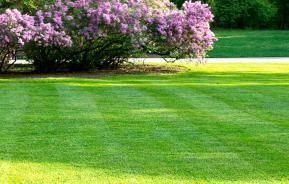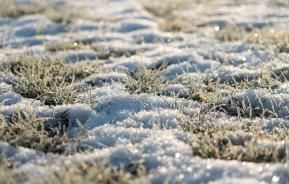So, how to look after your lawn? In our lawn care calendar, you’ll find monthly gardening tips outlining the essential steps to help take care of your grass. They are all specific to the UK weather, so your lawn can look its very best. We also have a handy infographic detailing the recommended and optimum times to do certain lawn care tasks.
Follow this monthly lawn planning and maintenance guide to have a great looking lawn all year round.
On this page:
- January Lawn Care
- February Lawn Care
- March Lawn Care
- April Lawn Care
- May Lawn Care
- June Lawn Care
- July Lawn Care
- August Lawn Care
- September Lawn Care
- October Lawn Care
- November Lawn Care
- December Lawn Care
- Lawn care cheat sheet
Lawn care by month
January lawn care
January is peak winter and the weather will often be cold and frosty.
Walking over your lawn during wet and frosty weather may cause localised puddling and compaction. The blades of grass can also become bruised, which will allow frost in, causing brown scorching. But don’t worry too much if you do walk on your lawn in winter, as come April, spiking the lawn will help to rectify the compaction and puddling issues.
Now is a good time to check over your garden tools and make sure they are all in good working order. This will make your garden chores easier, as blunt or damaged tools could slow you down and make for more hard work. Don’t forget to check your mower and spreader, these may need a service and parts may need replacing.
February lawn care
If the weather is mild and dry, take a walk over your lawn to inspect its condition. Does it feel soft and spongy underfoot? If so, you most likely have moss and/or thatch that should be treated in the spring. Removing this will promote grass to grow in these areas as well as improving its health.
Do you have weeds growing? Weeds will compete for moisture and nutrients, plus they can smother the grass. As with moss, a treatment needs to be applied starting from April, when the weeds are starting to grow. Make sure you only use a selective weedkiller or a special treatment such as MG Evergreen Complete 4in1 as you don’t want to kill off your grass at the same time.
Now you have inspected your lawn and know the problems you need to treat, why not look into the different products available and decide which is the best one for your lawn's needs?
March lawn care
As the spring weather slowly starts to appear, don’t be tempted to start applying any products, as it is still possible to get wet, wintery weather, which will stop the lawn and weeds growing, and prevent any treatment from working. Also any products applied may be washed away.
It may also be too early to start sowing grass seed. Grass seed needs warm soil to germinate quickly, and in early March the soil will still be too cold and risk of frosts are still likely. However, it does tend to get warmer in late March, so if it does you can get started on your lawn feeding schedule.
April lawn care
Spring has well and truly started and it’s time to start your lawn feeding and treatment programme now that the temperature is slowly beginning to rise and the risk of frost has lessened. This is what you should be doing:
Deal with weeds and moss in your lawn
Start by killing off the weeds and moss with the appropriate treatment as these will slowly be starting to grow in April. Remember to follow the instructions on the product to get the best possible results. Don’t rake the lawn before applying moss control, as this will spread the spores and encourage more moss to grow.
After you have applied your treatment and the moss has turned black, you will need to rake it out, allowing any new shoots of grass to fill in the gaps. If you have been left with any large bare patches, these can be dressed and new grass seed sown – just make sure you check the specific timeframe on the back of the product. Applying too soon could damage or kill off any new grass roots produced.
If you are applying a treatment using a spreader, make sure you have the correct spreader setting, as over application could scorch your lawn.
Prepare your lawn to sow grass seed
Now it’s time to prepare the area where you want to sow grass seed. You’ll likely find that weed seeds are lying dormant in the soil – these will often germinate as well, which can make your new lawn look untidy. They will however likely be annual weeds and will eventually die with regular mowing. If you have any perennial weeds they’ll need treating with the correct type of weedkiller – just make sure you wait until the new lawn areas are more than 2 months old.
Rake and spike the lawn as this will help with aeration and relieve compaction, which will encourage stronger and healthier root growth.
Mow your grass
If you have lots of worm casts on your lawn, make sure you brush them away before mowing, as constant soil contact with the blades will quickly blunt them leading to poor mowing. Worms are a sign your lawn is in good health and they also aid with aeration, and adding organic matter to the soil underneath.
Your grass will probably have grown to a height where it requires its first cut, then you can mow the lawn as and when needed. For everyday lawns that get a lot of heavy use you should cut down to a height of 3cm. For an ornamental lawn, take down to 2cm.
Keep your grass moist
You need to keep any areas moist where you have recently sown with new grass seed, as this will help the seed to germinate and establish a strong root system. When it comes to cutting this young grass for the first time, ensure your mower blades are sharp so it cuts the grass, as blunt blades will smash into the grass, possibly tearing it out of the ground.
May lawn care
If the weather was cold in April, now is a great time to sow grass seed and repair patches. In May, you should also keep up with the mowing and don’t forget the edges of the lawn.
It’s also essential to keep up with your feeding regime in May and treat any surviving weeds. If you have any new seeded and turfed areas, you should leave them for a time before you apply any feed or weed killer – around two to four weeks for weed killer and around six weeks for feed. Just make sure you check the back of any products you’re using for exact details of the time required.
June lawn care
You’ll be regularly mowing your summer lawn at this time of year – for everyday lawns you should adjust your cut height to 2.5cm, with 1.2cm for ornamental lawns. As there’s a chance the weather will turn hot and dry for a few weeks, you should raise the cutting height to prevent the base of the lawn being scorched. Also in hot, dry weather it’s best not to mow or apply a feed, as the grass has slowed its growing process down and may become scorched.
So, how much should you be watering your new grass? Established, well maintained lawns are very resilient to drought and don’t need watering.
If you are considering watering your lawn in June, make sure you give it a good soak by leaving the sprinkler on for an hour or more to allow the water to penetrate right into the soil. Spiking will also help. Timing is key when it comes to watering your lawn in summer – you should make sure you water in the early morning or late evening when it’s not too hot to avoid evaporation losses.
July lawn care
If you used Miracle-Gro EverGreen Complete 4 in 1 in early April, now is the time to use it again if weeds and moss are still a problem and there hasn’t been a drought. Remember you can only use it twice a year.
If you don’t have any weeds or moss, it’s always best to use a liquid feed in the summer such as Miracle-Gro EverGreen Fast Green, Miracle-Gro EverGreen Fast Green Spray & Feed.
Also, don’t forget to keep mowing.
August lawn care
Keep feeding if the weather is dry using a water soluble or spray liquid feed.
Keep mowing if it’s not drought conditions. If you go away on holiday and come back a couple of weeks later to long grass don’t be tempted to cut it all down in one go. Take it down in stages over the next week or so to prevent the base of the grass suffering scorch and extending recovery time.
Take a note of any bare patches, which can then be attended to in September.
Don’t forget to sit down in your garden on a nice day just to enjoy it! Why not have a picnic too?
September lawn care
Early September may be too dry to sow new grass seeds, but it is still a great time to start lawn TLC to repair summer damage and to prepare for the harsh winter to come.
When the weather allows you can seed any bare patches. First use a garden fork to spike the lawn and lift gently to crack the soil to remove compaction. Try to do this in dry conditions, as the soil will fracture more easily. Next, you should rake and then sow the seed. Then rake again into the surface of the soil and water.
If you’re turfing instead of sowing, after spiking give a final rake to level the soil before turfing, making sure to remove any stones. Thoroughly soak the soil before laying the turf, and water again once laid. Make sure you keep it moist until it’s established.
Keep mowing, gradually raising the height to 3cm.
Feed with autumn food such as Miracle-Gro EverGreen Autumn Lawn Care or Miracle-Gro EverGreen Premium Plus Autumn & Spring Lawn Food to toughen up the lawn for the winter, and kill off any moss present, which must be raked out when black. Spike the lawn to aid drainage over the winter.
Remove fallen leaves either by raking or raising the mower height and sucking up the leaves to shred them, which will help in the composting process.
October lawn care
If the weather didn’t allow sowing or turfing in September, it should be done this month. Early October really is your last chance to sow seed before winter.
Throughout October, you should make sure you are regularly removing fallen leaves off the grass, and picking up any fruits that have dropped. This will help keep the grass free from any diseases, and it can also be used in your compost bin. If the weather allows you can still use treatments and mow your lawn.
November lawn care
If you have not already done so, make sure to feed the lawn before winter sets in!
You can mow your lawn if really needed, but only if the weather is still mild – this will also remove any leftover leaves in the process.
December lawn care
Keep off the lawn in frosty or wet weather, stick to using the path.
A handy lawn care diagram
Whether aerating, weeding, feeding, seeding or mowing your grass, the below lawn care infographic details the perfect schedule for when each aspect of lawn care and maintenance is recommended and when is the optimum time to do it.
⬤ = Recommended timings
⬤ = Optimum recommended timings
| Task | J | F | M | A | M | J | J | A | S | O | N | D |
|---|---|---|---|---|---|---|---|---|---|---|---|---|
| Mowing (every 2 weeks early season, every week mid season, top if mild in Nov) | ⬤ | ⬤ | ⬤ | ⬤ | ⬤ | ⬤ | ⬤ | ⬤ | ||||
| Aerating | ⬤ | ⬤ | ⬤ | ⬤ | ⬤ | ⬤ | ⬤ | |||||
| Scarifying | ⬤ | ⬤ | ⬤ | ⬤ | ||||||||
| Watering | ⬤ | ⬤ | ⬤ | ⬤ | ⬤ | ⬤ | ||||||
| Turfing | ⬤ | ⬤ | ⬤ | ⬤ | ⬤ | ⬤ | ||||||
| Lawn Feed/Weed/Moss | ⬤ | ⬤ | ⬤ | ⬤ | ⬤ | ⬤ | ||||||
| Lawn Feed | ⬤ | ⬤ | ⬤ | ⬤ | ⬤ | ⬤ | ⬤ | |||||
| Lawn Feed/Moss | ⬤ | ⬤ | ⬤ | ⬤ | ⬤ | ⬤ | ||||||
| Lawn Feed/Weed | ⬤ | ⬤ | ⬤ | ⬤ | ⬤ | ⬤ | ||||||
| Broad Leaf Weed Control | ⬤ | ⬤ | ⬤ | ⬤ | ⬤ | ⬤ | ||||||
| Seeding | ⬤ | ⬤ | ⬤ | ⬤ | ⬤ | ⬤ | ⬤ | ⬤ | ||||
| Top Dressing | ⬤ | ⬤ | ⬤ | ⬤ | ⬤ | ⬤ | ⬤ | ⬤ | ⬤ | |||
| Autumn Feed/Moss | ⬤ | ⬤ | ⬤ |
This lawn planner has been created as a guide and does not take into account regional, or seasonal weather variations.
Looking for more lawn care tips and insights? Don’t forget to follow our YouTube channel and sign up to our newsletter.








